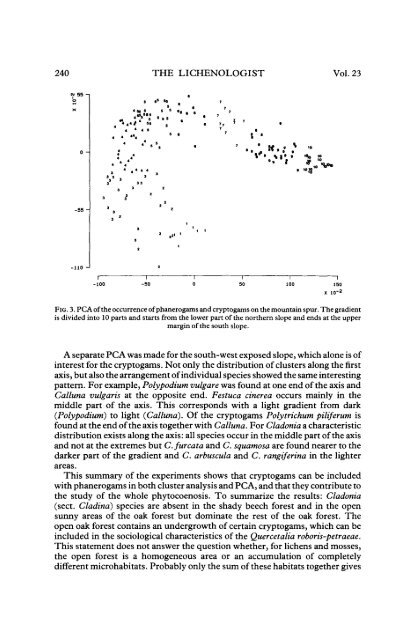23_237-252.pdf
23_237-252.pdf
23_237-252.pdf
Create successful ePaper yourself
Turn your PDF publications into a flip-book with our unique Google optimized e-Paper software.
240 THE LICHENOLOGIST Vol. <strong>23</strong><br />
4 * 4 5<br />
1 33<br />
'• X #<br />
. -a 1<br />
2<br />
,»< '<br />
FIG. 3. PCA of the occurrence of phanerogams and cryptogams on the mountain spur. The gradient<br />
is divided into 10 parts and starts from the lower part of the northern slope and ends at the upper<br />
margin of the south slope.<br />
A separate PCA was made for the south-west exposed slope, which alone is of<br />
interest for the cryptogams. Not only the distribution of clusters along the first<br />
axis, but also the arrangement of individual species showed the same interesting<br />
pattern. For example, Polypodium vulgare was found at one end of the axis and<br />
Calluna vulgaris at the opposite end. Festuca cinerea occurs mainly in the<br />
middle part of the axis. This corresponds with a light gradient from dark<br />
{Polypodium) to light {Calluna). Of the cryptogams Polytrichum piliferum is<br />
found at the end of the axis together with Calluna. For Cladonia a characteristic<br />
distribution exists along the axis: all species occur in the middle part of the axis<br />
and not at the extremes but C.furcata and C. squamosa are found nearer to the<br />
darker part of the gradient and C. arbuscula and C. rangiferina in the lighter<br />
areas.<br />
This summary of the experiments shows that cryptogams can be included<br />
with phanerogams in both cluster analysis and PCA, and that they contribute to<br />
the study of the whole phytocoenosis. To summarize the results: Cladonia<br />
(sect. Cladina) species are absent in the shady beech forest and in the open<br />
sunny areas of the oak forest but dominate the rest of the oak forest. The<br />
open oak forest contains an undergrowth of certain cryptogams, which can be<br />
included in the sociological characteristics of the Quercetalia roboris-petraeae.<br />
This statement does not answer the question whether, for lichens and mosses,<br />
the open forest is a homogeneous area or an accumulation of completely<br />
different microhabitats. Probably only the sum of these habitats together gives
















